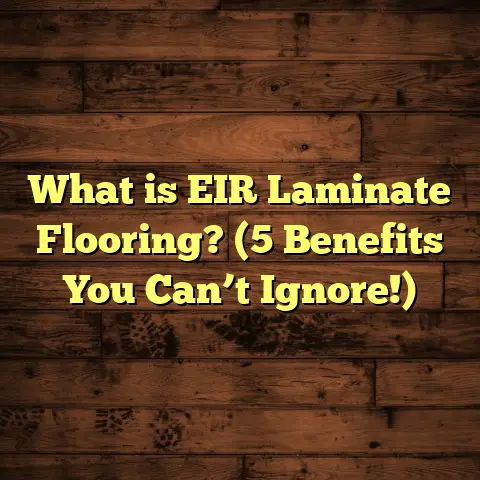What is Floor Refinishing? (5 Key Benefits for Your Home)
Maintaining a beautiful home floor without spending countless hours
scrubbing and cleaning is something I always aim for. Floors are a major
part of any home, and having them look fresh and well-kept can make daily
life easier. That’s where floor refinishing steps in. It’s a way to keep your
floors stunning without the hassle of replacing them entirely. If you’ve ever
wondered what floor refinishing really means or how it can benefit your
home, I’ve got some insights to share from my years working in flooring.
What is Floor Refinishing?
So, what exactly is floor refinishing? At its core, floor refinishing
means restoring the surface of your existing hardwood floor to bring back
its original shine and smoothness. Instead of tearing out the whole floor
and installing new materials, refinishing works with what you already have.
The process usually involves sanding down the top layer of the wood to
remove scratches, dents, and any worn-out finish. Then, new coats of stain
and protective finish are applied to enhance the wood’s appearance and
durability. It’s like giving your floor a fresh start—only without the mess
and expense of a full replacement.
I often tell homeowners that refinishing is like hitting the reset button
on their floors. Over time, dirt, pet claws, furniture marks, and everyday
wear dull the surface. But with refinishing, you strip all that away and
reveal the beautiful wood underneath.
More About the Refinishing Process
Let me break down those steps a bit more because knowing how each part
works helps you appreciate what goes into making your floors look new
again.
- Sanding: This is the most important step. We use industrial-grade sanders to strip away the old finish and any damaged or stained wood on the surface. It’s not just about aesthetics; sanding smooths out unevenness and removes minor damage that could worsen over time.
- Staining: This is optional depending on whether you want to change or refresh the floor color. Different stains can add warmth or coolness depending on your décor style.
- Sealing: After staining (or if you skip it), several coats of sealant protect your floor from moisture, scratches, and wear. Polyurethane finishes are common because they’re durable and come in different sheens.
- Drying: Each coat needs time to dry thoroughly before adding the next one or walking on the floor again. It usually takes several days for the entire process.
A question I often get is: “Can every hardwood floor be refinished?” The answer is mostly yes, as long as your floors haven’t been sanded down too many times before or damaged beyond repair by water or rot. Usually, a hardwood floor can be refinished 3-4 times over its lifetime.
How Does Refinishing Differ From Other Floor Treatments?
You might hear about buffing or screening as alternatives to refinishing. These are lighter treatments that don’t involve full sanding but rather smooth and recoat the existing finish.
Buffing is great for floors in good shape that just need a little shine boost. However, if your floors have deep scratches or worn spots, full refinishing is usually necessary.
1. Cost-Effective Way to Refresh Your Floors
One of the biggest perks of refinishing is the cost savings. Replacing hardwood floors can easily run into thousands of dollars depending on the size of your space and the type of wood you choose.
For example, new hardwood installation often costs $8 to $14 per square foot including materials and labor. In contrast, refinishing typically ranges from $3 to $7 per square foot depending on location and job complexity.
That means for a 300-square-foot room:
- New flooring: $2,400 – $4,200
- Refinishing: $900 – $2,100
This savings can be significant when you’re updating multiple rooms or working within a tight budget.
When I plan projects, I rely on tools like FloorTally to help me get accurate cost estimates quickly. It factors in local labor rates, material choices, and even waste factors so I can provide clients with realistic budgets upfront. That way, there are no surprises down the road.
Case Study: Budgeting for a Living Room Makeover
A client recently wanted to freshen up their 400 square foot living room with old maple hardwood floors. They considered replacement but were concerned about cost and time.
Using FloorTally, I ran estimates comparing new engineered hardwood vs. refinishing:
| Option | Estimated Cost | Time Required | Disruption Level |
|---|---|---|---|
| New Engineered Hardwood | $4,800 | 5-7 days | High |
| Refinishing | $1,800 | 3 days | Low |
The client chose refinishing and was thrilled with both savings and minimal disruption during the project.
Hidden Costs to Watch For
Sometimes homes have extra challenges like:
- Multiple layers of old finish
- Deep gouges or water damage requiring repairs
- Furniture moving fees
These can add to refinishing costs but still generally remain less than full replacement.
2. Extends the Life of Your Hardwood Flooring
Hardwood floors are durable but not indestructible. Without proper care, they show signs of wear after years of foot traffic, spills, and pets.
Refinishing restores the protective layer on top of the wood, which can wear off over time. By sanding away damaged finishes and applying fresh sealants, you actually prolong the life of your floors by decades.
In fact, many hardwood floors last 50+ years with refinishing done every 7-10 years depending on use. That’s far longer than most other flooring options last without significant replacement.
I once worked on a historic home where the original hardwood floors were over 80 years old! They had been refinished multiple times but still looked fantastic—and they will last for generations more thanks to this maintenance.
Data Insights: Longevity Comparison
Looking at flooring lifespan data:
| Flooring Type | Typical Lifespan (Years) | Maintenance Notes |
|---|---|---|
| Hardwood (refinished) | 50+ | Refinish every 7-10 years |
| Laminate | 10-20 | Replacement needed after wear |
| Vinyl | 10-15 | Replacement after damage |
| Carpet | 5-10 | Regular replacement & cleaning |
Choosing hardwood with refinishing clearly wins for longevity.
How Proper Maintenance Helps
Beyond refinishing itself, I always advise clients on upkeep habits that preserve their floor’s life:
- Clean spills immediately
- Use area rugs in high-traffic zones
- Avoid harsh chemicals
- Refinish before damage becomes severe
3. Improves Indoor Air Quality
Have you ever thought about how floors affect your home’s air? Dust, allergens, and even chemical residues can get trapped in flooring materials.
Old finishes on hardwood floors may contain outdated chemicals or simply trap dust particles that get kicked up into the air when people walk around.
Refinishing removes these old layers and replaces them with modern, low-VOC (volatile organic compound) finishes that are much safer for indoor air quality.
This change can reduce allergy symptoms and make your home feel fresher.
I remember helping a client whose child had allergies improve noticeably after we refinished their floors using eco-friendly products. It was rewarding to see how this simple step made a real difference in their day-to-day comfort.
Scientific Backing
According to an Environmental Protection Agency (EPA) study:
- Homes with hardwood floors have 30% less dust accumulation than carpeted homes.
- VOC emissions from older finishes can trigger respiratory irritation.
- Using low-VOC finishes reduces indoor pollutants significantly.
Choosing Safe Finishes
When selecting sealants for refinishing, I recommend:
- Water-based polyurethane finishes (low odor and VOC)
- Natural oils (like tung oil) for those wanting chemical-free options
- Avoiding oil-based polyurethanes if allergies are a concern
These choices contribute greatly to healthier indoor air quality after refinishing.
4. Customizes Your Floor’s Appearance
Maybe you’re tired of the color or finish of your current floors. Refinishing gives you a chance to change that without ripping everything up.
By choosing different stains or finishes—like matte vs. glossy—you can completely alter the look of your hardwood floors to match your updated style or décor.
In my experience, clients often love this flexibility because it feels like getting brand-new floors tailored exactly how they want them.
For example, one client switched from a traditional oak stain to a darker walnut shade during refinishing and said it transformed their entire living space’s vibe.
Popular Stain Options
Here are some common stain colors people choose when refinishing:
- Natural: Keeps wood’s original tone bright.
- Honey/Golden Oak: Adds warmth without darkening too much.
- Walnut/Dark Brown: Creates rich contrast.
- Gray/Weathered: For modern rustic looks.
- Whitewash: Lightens floors for airy feel.
Your choice depends on lighting, furniture style, and personal taste.
Finish Sheens and Their Impact
Finish sheen affects not only look but also feel:
| Sheen Level | Description | Durability Impact |
|---|---|---|
| Matte | Soft, natural look | Hides scratches well |
| Satin | Slight shine | Popular balance option |
| Semi-gloss | Noticeable shine | More reflective |
| High-gloss | Very shiny | Shows scratches more easily |
Choosing matte or satin finishes tends to be best for busy households since they mask wear better over time.
5. Adds Home Value
If you’re thinking about selling your home someday or just want to keep it in great condition for years, refinished floors add real value.
Buyers notice well-maintained hardwood floors instantly—they’re often at the top of wish lists because they signal a cared-for home.
According to recent real estate data from Zillow:
- Homes with hardwood floors sell approximately 17% faster than those without.
- Refurbished hardwood floors can increase home value by up to 5%.
- Floors that look new make homes more appealing in photos and showings.
That boost in resale value makes refinishing a smart investment if you want your home to stand out in the market.
Real Estate Agent Perspective
A realtor friend told me sellers often get multiple offers when their homes have freshly refinished hardwood floors because buyers see them as move-in ready and less likely to need repairs soon after purchase.
What Happens During Floor Refinishing?
You might wonder how all this works step-by-step. Here’s what I usually follow:
- Preparation: Move furniture and clean floors thoroughly.
- Sanding: Use specialized machines to sand off old finishes and smooth out imperfections.
- Staining: Apply stain if changing color is desired.
- Sealing: Coat with protective finishes like polyurethane.
- Drying: Allow time for finishes to dry completely before walking on floors again.
The whole process takes about 3-5 days depending on room size and number of coats applied.
Tips for Preparing Your Home Before Refinishing
If you decide to refinish your floors yourself or hire a pro like me, preparing your home makes a big difference:
- Clear out as much furniture as possible.
- Remove curtains or wall hangings near windows (dust can spread).
- Seal off other rooms with plastic sheeting if possible.
- Plan for some downtime as you won’t be able to use the room during drying.
When Should You Refinish Your Floors?
Not sure if your floors need refinishing? Here are some signs I look for:
- Visible scratches and dents
- Faded or worn finish
- Water damage or discoloration
- Rough spots or splintering
If your floor looks tired or damaged but still has solid wood underneath, refinishing is probably what you need.
My Tips for Maintaining Refinished Floors
After working hard on refinishing, keeping floors looking good is key:
- Use soft-soled shoes indoors
- Place felt pads under furniture legs
- Clean regularly with wood-safe products
- Avoid excess water during cleaning
- Reapply finish every few years as needed
DIY vs Professional Refinishing: What You Should Know
Some folks ask if they should try refinishing themselves instead of hiring a pro like me. Here’s my take based on experience:
DIY Pros:
- Can save money upfront
- Good for small areas or budget projects
- Satisfaction from doing it yourself
DIY Cons:
- Requires renting/sourcing specialized equipment
- Risk of uneven sanding or blotchy stain
- Time-consuming and messy
- Proper ventilation needed due to dust/fumes
Professional Pros:
- Expertise ensures even sanding & perfect finish
- Faster turnaround time
- Access to high-grade materials & equipment
- Warranty or guarantees on work quality
Professional Cons:
- Higher initial cost
- Scheduling needed around availability
Personally, I recommend professionals if you want guaranteed results without frustration—especially for large areas or valuable flooring.
Common Challenges in Floor Refinishing & How I Handle Them
Every project has surprises. Here are typical challenges I’ve encountered:
- Old paint or glue residue: Requires extra sanding passes.
- Water stains: Sometimes soaked deep; may need special treatments.
- Uneven boards: Need filling or minor repairs before finishing.
- Dust control: Using high-quality vacuums during sanding minimizes mess.
Facing these issues head-on keeps projects smooth and results stunning.
Eco-Friendly Flooring Refinishing Practices
I’m often asked about environmentally conscious flooring options during refinishing projects. Here’s what I do:
- Use low-VOC stains & finishes approved by GreenGuard.
- Properly dispose of sanding dust as it can be hazardous.
- Reuse existing wood instead of replacing it reduces waste.
- Offer natural oil finishes that avoid synthetic chemicals.
Choosing eco-friendly products benefits both my clients’ health and the planet.
Tools & Technology That Help Me Work Smarter
Technology has improved how we refinish floors:
- Automated sanding machines reduce labor time.
- Dust containment systems keep homes cleaner.
- Digital moisture meters ensure wood dryness before finishing.
- Project management apps help me schedule jobs efficiently.
FloorTally is another tool I trust for budgeting—it compiles local labor rates and materials prices quickly so I can advise clients transparently on costs based on their exact project specs.
Flooring Trends I’ve Seen Impact Refinishing Choices
Over my years working with homeowners, trends affect how people want their floors finished:
- More demand for matte & satin finishes (less shiny).
- Popularity of gray & weathered stains for modern interiors.
- Preference for wider planks that show off grain better.
- Interest in hand-scraped textures combined with smooth finishes.
Understanding these trends helps me guide clients toward styles that stay attractive longer while fitting current aesthetics.
Personal Story: A Challenging Project That Taught Me A Lot
I remember working on an old farmhouse where floors were damaged not just by age but by years of pet wear and moisture issues under windows.
The family wanted to keep original planks but needed extensive prep work—filling gouges, addressing slight warping—and careful stain selection because sunlight faded parts unevenly.
It took longer than usual but seeing their faces when we finished was priceless—they got exactly what they hoped for: character-rich floors that felt brand new but preserved history.
That project reminded me why refinishing is part craft, part science—and why every floor tells its own story.
Final Thoughts
Floor refinishing has been one of my favorite flooring services to offer because it’s effective, affordable, and gives homes a fresh look quickly. If you want easy maintenance while keeping your floors beautiful for years, it’s definitely worth thinking about.
Have you ever tried refinishing your floors? What was your experience like? If not, maybe now’s the time to consider it—you might be surprised at how much life you can bring back to your home’s foundation with just a little work.
If you want help estimating costs or exploring options tailored to your home’s unique needs, feel free to ask—I’m here to help!





